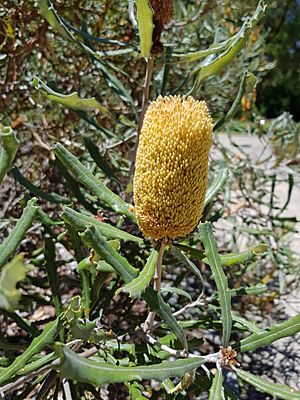Banksia pilostylis facts for kids
Quick facts for kids Banksia pilostylis |
|
|---|---|
 |
|
| Banksia pilostylis in Kings Park | |
| Scientific classification | |
| Genus: |
Banksia
|
| Species: |
pilostylis
|
Banksia pilostylis is a special kind of shrub. It grows only in the southwest part of Western Australia. This plant has tough, cracked bark. Its leaves are narrow and have jagged edges. It produces pale yellow flowers that grow in long, cylinder shapes. After flowering, it forms oval-shaped seed pods called follicles. These pods usually open up only when there's a bushfire.
Contents
What it Looks Like
Banksia pilostylis is a shrub that can grow up to about 4 meters (about 13 feet) tall. It has bark that is hard and looks like it has many cracks. Unlike some other plants, it doesn't have a special underground stem called a lignotuber that helps it regrow after a fire.
Its leaves are narrow and shaped like a wedge. They have jagged edges, like a saw. These leaves are usually 50 to 160 millimeters (about 2 to 6 inches) long. They are also 5 to 20 millimeters (about 0.2 to 0.8 inches) wide. Each leaf sits on a short stem called a petiole, which is about 4 to 6 millimeters long.
The flowers are a pale yellow color. They grow tightly packed together in a cylindrical (tube-shaped) spike. Each spike is about 50 to 100 millimeters (2 to 4 inches) long. It is also about 50 to 55 millimeters (2 to 2.2 inches) wide. At the bottom of the flower spike, there are hairy leaf-like parts called involucral bracts. These are 5 to 20 millimeters long.
The flower's outer parts, called the perianth, are 20 to 24 millimeters long. The female part of the flower, the pistil, is 23 to 27 millimeters long and has a curved shape.
Banksia pilostylis flowers from October to January. After the flowers, up to twenty-five oval-shaped seed pods develop. These pods, called follicles, are 22 to 35 millimeters (about 0.9 to 1.4 inches) long. They are also 10 to 16 millimeters (about 0.4 to 0.6 inches) wide. The dried remains of the flowers surround these pods. The follicles usually stay closed. They only open up to release their seeds when the plant is killed by a bushfire.
How it Was Named
Banksia pilostylis was first officially described in 1964. A botanist named Charles Gardner gave it its name. He wrote about it in the Journal of the Royal Society of Western Australia. He had collected samples of the plant in October 1960.
The second part of its scientific name, pilostylis, comes from a Latin word. It means "hairy style". The style is a part of the flower's pistil.
Later, in 1981, another scientist named George placed this species into a group called Cyrtostylis. In 1996, a study using cladistic analysis (a way to study how living things are related) confirmed this grouping.
Where it Grows
This banksia plant grows in areas with shrubs and low woodlands. You can find it near the south coast of Western Australia. It grows between the towns of Ravenshorpe and Israelite Bay.
Its Protection Status
The Western Australian Government's Department of Parks and Wildlife says that Banksia pilostylis is "not threatened". This means it is not currently in danger of disappearing.
Growing it at Home
If you want to grow Banksia pilostylis from seeds, you don't need to do anything special to the seeds first. They usually take about 18 to 49 days to germinate (start growing).
- Taylor, Anne; Hopper, Stephen (1988). The Banksia Atlas (Australian Flora and Fauna Series Number 8). Canberra: Australian Government Publishing Service. ISBN 0-644-07124-9.

